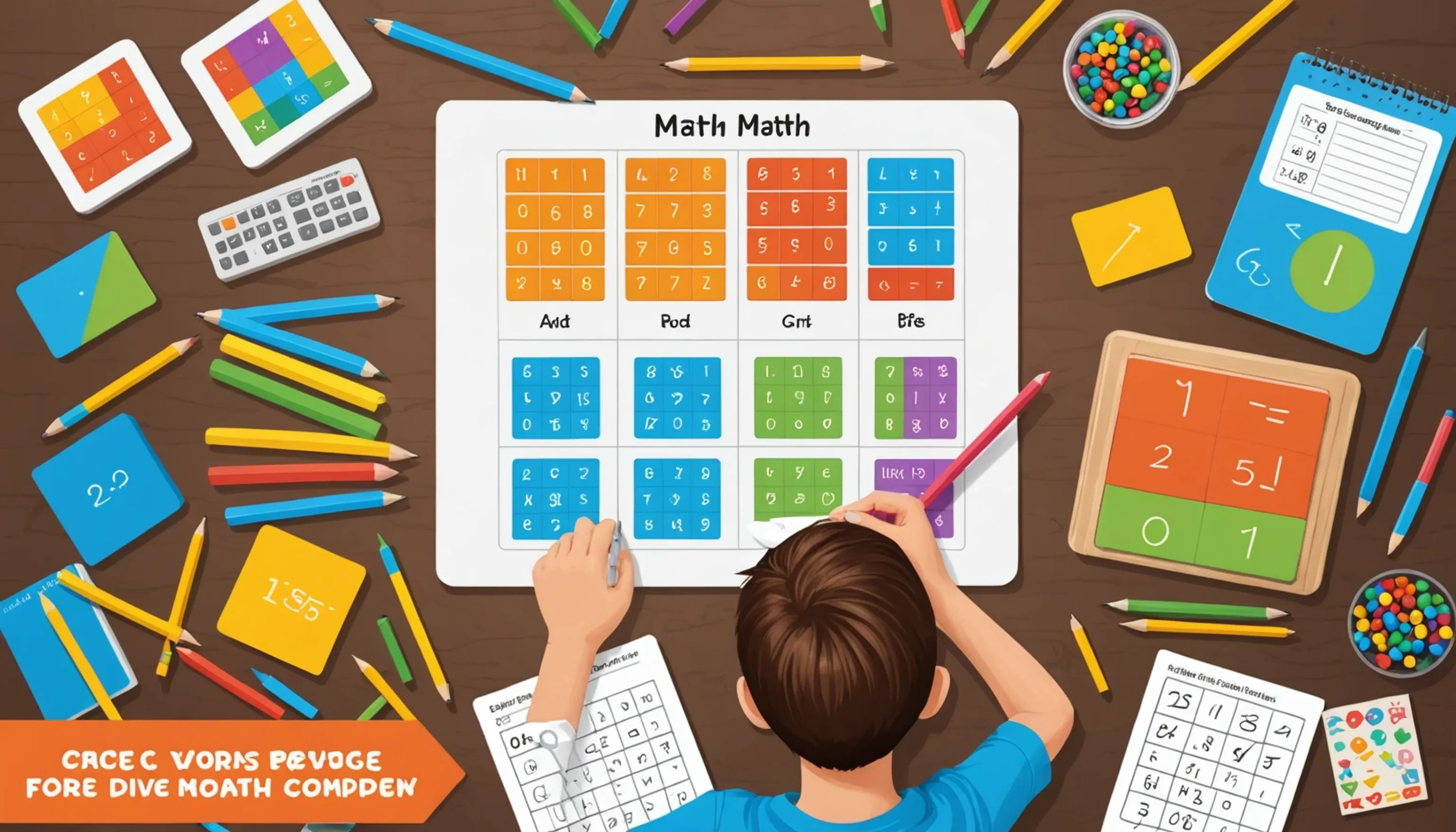Why Legacy Math Games Only Work for Young Kids
 HvWHenry van Wagenberg
HvWHenry van Wagenberg
Understanding Why Legacy Math Games Suit Young Kids
Legacy math games are primarily designed to cater to the developmental stages of young kids. These games often incorporate simple rules, colorful visuals, and engaging storylines that capture the attention of younger audiences. Young children are typically in a phase of concrete operational thinking, where they learn best through hands-on experiences and play.
These games promote basic math skills, such as counting and simple addition, in a fun and interactive way. The immediacy of rewards and the playful nature of these games effectively motivate young kids to engage, making them an ideal fit for early learners.
Developmental Differences Between Young Kids and Teens
The developmental differences between young kids and teens significantly impact how they engage with math games. Young children are typically in the preoperational to concrete operational stages of cognitive development, according to Piaget's theory. This means they learn best through concrete experiences and play. At this stage, children enjoy games that are visually stimulating and interactive, which help them grasp basic math concepts like counting, addition, and subtraction.
In contrast, teenagers are in the formal operational stage, where they develop the ability to think abstractly and critically. They are capable of understanding complex concepts, and their cognitive skills allow them to solve problems that require higher-level thinking. As a result, traditional legacy math games often fail to engage teens because they may find them too simplistic and unchallenging.
Moreover, teens are increasingly seeking relevance in their learning experiences. They prefer games that connect math concepts to real-world scenarios and practical applications. This desire for relevance can make legacy games, which often lack depth and complexity, less appealing to this age group.
Additionally, teenagers have different social dynamics compared to younger children. They often seek collaborative or competitive experiences that are not typically provided by legacy math games. In summary, understanding these developmental differences is crucial for creating math games that effectively engage both young kids and teens.
Engagement Levels in Math Games
Engagement levels in math games vary significantly between young kids and teenagers, primarily due to their differing cognitive abilities and interests. For young children, math games are often designed to be fun and interactive, using vibrant colors and playful themes that capture their attention. These games incorporate basic math skills through enjoyable activities, such as counting objects or solving simple puzzles, which align with their developmental stage. The sense of achievement and immediate rewards from these games keep young kids engaged and motivated to learn more.
On the other hand, teenagers require a different approach to maintain their engagement in math games. As they mature, their interests shift toward challenges that stimulate critical thinking and problem-solving. Traditional legacy math games may seem too simplistic for them, leading to boredom and disengagement. Teenagers often seek out games that incorporate elements of strategy, competition, and real-world applications. Games that present complex scenarios and require collaborative efforts tend to hold their interest longer.
Furthermore, the social dynamics among teenagers play a crucial role in their engagement levels. They enjoy competitive and cooperative play, where they can work in teams or compete against peers. This element of social interaction can enhance their motivation to participate in math games. Therefore, understanding the varying engagement levels based on age and cognitive development is essential for creating effective math learning experiences that resonate with both young kids and teenagers.

Cognitive Skills and Math Learning
Cognitive skills are crucial in math learning, and they develop differently between young kids and teenagers. For young children, math learning often focuses on foundational skills such as counting, number recognition, and basic operations. At this stage, children are developing their working memory and visual-spatial skills, which are essential for understanding simple mathematical concepts. Engaging with colorful math games helps strengthen these cognitive abilities, as children learn through play and hands-on experiences.
As children transition into their teenage years, their cognitive skills become more advanced. They begin to develop abstract reasoning and critical thinking skills, which allow them to tackle complex mathematical concepts. Teenagers are capable of understanding variables, functions, and advanced problem-solving techniques. This shift requires math games that challenge their cognitive abilities and encourage higher-order thinking.
Moreover, teenagers often benefit from games that incorporate strategic thinking and real-world applications. They need to see how math connects to their lives, whether through budgeting, coding, or statistical analysis. Engaging math games for teens should challenge their cognitive skills while providing opportunities to apply what they've learned in practical scenarios.
Ultimately, recognizing the differences in cognitive skill development between young kids and teenagers is essential for creating effective math learning experiences. Tailoring math games to meet these developmental needs can enhance engagement and promote a deeper understanding of mathematical concepts across age groups.
Limitations of Legacy Math Games for Teens
Legacy math games often fall short in meeting the needs of teenagers due to several limitations. Firstly, these games typically present overly simplistic challenges that fail to engage teens who seek more complex problem-solving opportunities. The lack of depth in content can lead to boredom, as teenagers require games that stimulate their critical thinking and abstract reasoning skills.
Additionally, legacy games usually lack real-world relevance, which is essential for teen engagement. Without connections to practical applications or contemporary issues, these games can seem disconnected from the interests and experiences of adolescents.
Lack of Challenge in Legacy Math Games
One of the primary criticisms of legacy math games is their lack of challenge for teenagers. These games often cater to younger audiences, focusing on basic arithmetic and foundational skills that do not resonate with the advanced cognitive abilities of teens. This lack of challenge manifests in several ways:
- Overly Simple Tasks: Many legacy games consist of repetitive tasks that do not require critical thinking or problem-solving. As a result, teenagers quickly lose interest.
- Limited Scope: These games usually cover basic concepts without diving into more complex topics such as algebra, geometry, or statistics. Teens are ready for deeper mathematical exploration, and legacy games often miss the mark.
- Insufficient Strategy: Teens often thrive on strategic and competitive play. Legacy math games typically lack elements that require planning and foresight, leading to disengagement.
Furthermore, teenagers are at a stage where they crave intellectual stimulation. They want challenges that push their limits and encourage them to think critically. When games fail to provide this level of engagement, they risk being dismissed as unworthy of their time.
In summary, the lack of challenge in legacy math games not only affects engagement but also hampers the development of essential cognitive skills in teenagers. To foster a love for math, it's crucial to introduce games that challenge and stimulate their minds.

Relevance of Content for Teenagers
The relevance of content in math games is crucial for engaging teenagers effectively. Unlike younger children, who may find joy in colorful visuals and simple tasks, teens require connections between the content and their real lives. When math games lack this relevance, they often fail to capture the interest of adolescent learners. Here are a few ways in which content relevance impacts teen engagement:
- Real-World Applications: Teens are more likely to engage with math games that incorporate real-world scenarios. For instance, games that simulate budgeting, investing, or statistics related to sports or science can demonstrate how math is applicable in daily life.
- Current Trends: Incorporating popular culture, technology, and social issues into math content can make games more relatable. For example, using themes from social media or gaming can attract teens who might otherwise be uninterested in traditional math problems.
- Personal Interests: Tailoring math games to include content that resonates with teenagers’ personal interests—such as music, sports, or environmental issues—can significantly enhance engagement. When teens see math as a tool to explore their passions, they are more likely to invest time and effort in learning.
Ultimately, the relevance of content in math games should align with the interests and experiences of teenagers. By creating games that connect mathematical concepts to their lives, educators and game developers can foster deeper engagement and a more meaningful learning experience.
The Need for Interactive Learning Approaches
In today's educational landscape, there is a growing need for interactive learning approaches, particularly in the realm of math education. Traditional teaching methods often fail to engage students, especially teenagers, who thrive on active participation and collaboration. Interactive learning strategies promote deeper understanding and retention of mathematical concepts by encouraging students to be active participants in their learning journey.
Interactive approaches can include hands-on activities, collaborative projects, and technology-integrated games that foster a sense of community and teamwork among students. These methods allow teens to explore mathematical concepts in a meaningful way, connecting theory with practical applications.
Moreover, interactive learning nurtures critical thinking and problem-solving skills, essential for success in higher education and the workforce. By embracing interactive learning approaches, educators can create a more engaging and effective math learning environment that meets the diverse needs of teenagers.
Modern Math Games That Engage Teenagers
Modern math games designed for teenagers focus on engaging their interests while challenging their cognitive skills. Unlike traditional legacy math games, these contemporary options incorporate elements that resonate with teens, making math learning both enjoyable and relevant. Here are some types of modern math games that effectively engage teenagers:
- Real-World Simulations: Games that simulate real-life scenarios, such as managing a budget, investing in stocks, or running a business, provide teens with practical applications of math. These games help them understand the importance of mathematics in everyday decision-making.
- Collaborative Challenges: Many modern games encourage teamwork and collaboration. By working in groups to solve complex problems, teens not only engage with mathematical concepts but also develop essential communication and interpersonal skills.
- Technology-Enhanced Learning: With the rise of digital platforms, math games that utilize apps and online resources can create interactive experiences. These games often include levels, rewards, and leaderboards that motivate teens to improve their skills through friendly competition.
- Gamified Learning Experiences: Incorporating game mechanics, such as quests, achievements, and narrative storytelling, can turn math learning into an adventure. This approach keeps teens excited about mastering new concepts and encourages consistent practice.
By embracing these modern math games, educators can create a dynamic learning environment that captures the attention of teenagers and fosters a lasting appreciation for mathematics.
Incorporating Real-World Applications in Math Games
Incorporating real-world applications into math games is essential for engaging teenagers and enhancing their understanding of mathematical concepts. When teens can see the relevance of math in their daily lives, they are more likely to invest time and effort into learning. Here are some effective strategies for integrating real-world applications into math games:
- Financial Literacy: Games that involve budgeting, investing, or managing expenses can teach teens valuable skills. For instance, creating a game where players manage a virtual business requires them to apply concepts like percentages, profit margins, and financial forecasting.
- STEM Challenges: Math games that incorporate elements of science, technology, engineering, and mathematics (STEM) can captivate teens' interests. Challenges that involve building structures, coding, or solving engineering problems provide hands-on experiences that emphasize the practical use of math.
- Data Analysis: Incorporating games that require data collection and analysis helps teens understand statistics and probability. For example, analyzing sports statistics or conducting surveys can make math relatable and engaging.
- Environmental Issues: Games that address real-world challenges, such as climate change or resource management, can motivate teens to use math to solve pressing problems. For example, a game that simulates the impact of various energy sources can illustrate the importance of math in making informed decisions.
By embedding real-world applications into math games, educators can foster a deeper connection between math and everyday life, ultimately making learning more meaningful and effective for teenagers.
